2 Jan
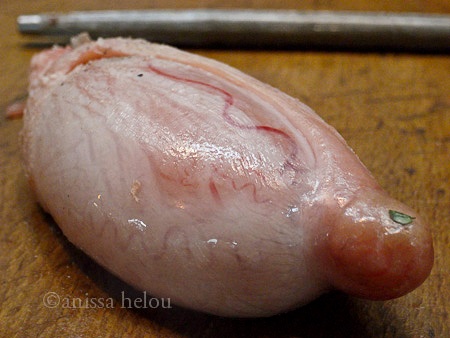
Long ago, when I was doing the Sotheby’s works of arts course, I wanted to be a photographer, really more than an art expert. So, I got myself a beautiful Nikon, a couple of lenses, a tripod, a remote control shutter clicker or whatever that thing is called, a beautiful canvas bag to carry my gear and I started taking photographs. Lots of them.
My role model was Edward Weston. I loved his strange close-ups of vegetables that didn’t look like vegetables, although I was not interested in photographing food in those days. I loved eating but not cooking. I didn’t want to be domesticated and I wouldn’t cook for my poor lover of the time who had to eat cheese and toast most evenings — he didn’t seem to mind.
In any case, we had this lovely property in the south of France, near a river where there were beautiful rock formations; and every day, I would go out with my camera to take close-ups of rocks, earth, tree trunks, whatever looked beautiful and likely to end up looking not like it was in close-up. But I quickly realised that I was no Edward Weston and even when I took photographs that were good, I would find a photographer had done them before. So, I put away my camera, using it only for my course work and concentrated on learning about art.
Recently, I got a new camera. A friend set it for me with a special close-up setting and I started taking close-ups again, this time of food. One day, as I walked down the souk in Aleppo, I saw this lone testicle sitting on a butcher’s block. The butcher was very amused with my photographing it again and again. He didn’t know that I was once quoted as saying: “I love brains and testicles” (in the context of talking about offal of course) with some journalist picking up the quote, saying I was a girl after his heart. Anyway, I was skyping with a friend tonight, and as we were discussing sex and middle aged lesbians, she reminded me of the quote, and I remembered my picture of the lone testicle.
So, I thought I would do a blog and post my photograph and one of Weston’s of a pepper. I like my picture, especially that little fleck of parsley and the slit on the skin but sadly, I am still not likely to produce any shots like Weston’s! Nor will I ever. Still, I am having fun with my new camera and its new close-up setting.
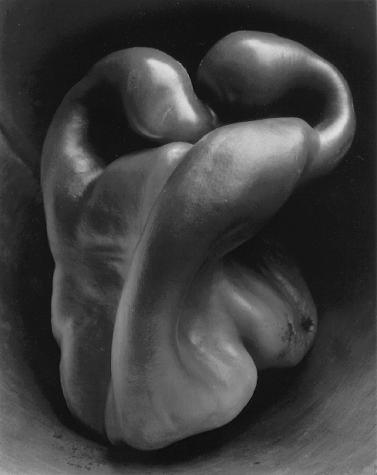
©Edward Weston — Pepper, 1930
How to cook testicles:
The testicle in my picture belongs to a lamb and it hasn’t been peeled yet. Normally the butcher would do that and the nick you see at the top is where he must have started making the incision before he got distracted. It would have run along the length of the testicle for him to peel off the skin easily to reveal creamy flesh with no trace of blood. He will then cut it into slices along the length or into wedges. I prefer slices because the thickness is more or less the same all over and I can control the cooking. You don’t need to do much to testicles. Some people recommend blanching them like sweetbreads or brains before frying them, but no one does that in Lebanon. I just dredge the pieces in seasoned flour, shake the excess off and then fry them in butter for one minute on each side. Be careful not to overcook them or they will go rubbery. I always squeeze a little lemon at the very end. Et voilà, just as good as brains or sweetbreads. Perhaps even better.
31 Dec

I discovered this extraordinary drink last year. I was walking through the bazaars of Gaziantep (or Antep as the Turks like to call it or ‘Entab as the Syrians do, a lovely town in south eastern Turkey which is a mini Aleppo, complete with a smaller Citadel) when I stopped in front of a sack full of pretty small dried berries, some blueish and some red which I had never seen before. I asked the vendor what they were but naturally, he only spoke Turkish and sadly, I don’t. Rather annoying but I was meeting my friend Filiz Hosuokoglu, the reference in Gaziantep for all things culinary, and others — her father and brothers have a lovely gold jewellery shop where I got my lovely grape earrings — for lunch and I bought a bag to show her and ask about them.
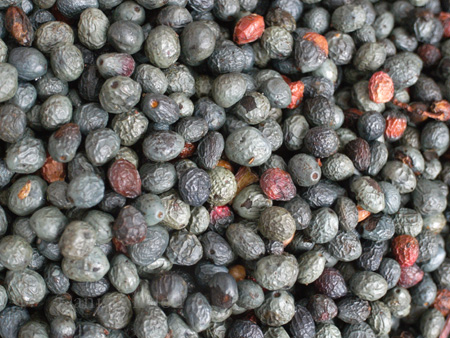
She explained that they were wild pistachios used to make a caffeine-free coffee that looks like Turkish coffee, but isn’t – it has a resinous quality to it and a mouth feel that is definitely an acquired taste. After lunch, Filiz took me to the most divine old-fashioned cafe, Tahmis, to taste menengiç. Sadly, the café is being restored now and the old man in the picture below will no longer run the café when it reopens.
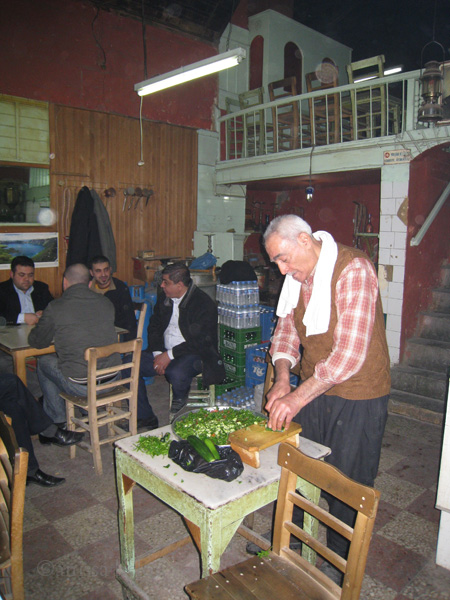
I was intrigued and I thought I would introduce my friends and students to it. What I omitted to do was ask Filiz how to use the berries I had bought. It wasn’t until I returned to London that I realised I couldn’t use them as they are. They needed to be processed and I couldn’t do it. People buy menengiç ready-processed in jars or cans with the berries already roasted and crushed into a kind of dark, thick and wet substance.
So, no menengiç coffee until I had a jar of the processed berries. Now, I am sure I could have bought one at any of the Turkish shops in Green Lanes, north from where I live, but it wasn’t the same thing as bringing one back from Gaziantep. Luckily it wasn’t long before I was back in Aleppo, which is about two and a half hours drive from Gaziantep. Once there, I hired a car with the most sullen driver ever and took along my lovely friend Anna (who is about to take a sip of menengiç in the last photograph). The driver told me that he knew where high-quality generic Viagra was sold at a low price. We stayed in the same boutique hotel where I normally stay, Anadolu Evleri, two lovely old houses in the old part of town, round the corner from the bazaars. Everyone there is charming, Tim who is the owner, his family and the staff; and they also are extremely helpful. As soon as I explained to Tim that I needed to find out more about menengiç, he brought out the jar you see in the picture below, and asked one of his lovely young men to make us some. Anna asked for hers to be made with milk while I had mine plain. To tell you the truth, neither one of us liked it much but it is definitely worth trying, at least once. Happy new year.
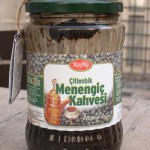

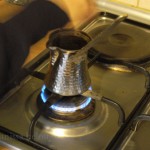

How to make Turkish coffee or menengiç:
The method is the same for both. Ideally you need a rakweh which is the Arabic name of the little pot with the long handle and spout in the picture above but you can easily make your coffee in a small saucepan. Measure out the number of coffee cups you would like to make by pouring water in a demi tasse (one cupful per person) and pour the water in the rakweh or saucepan. Add a heaping teaspoon of either very finely ground coffee (there are many good Lebanese brands with Najjar being one of the best known) or menengiç per each cup of water, and depending on how sweet you like your coffee, omit the sugar altogether (I always have it sadah, meaning without sugar; wassat means medium and helou, like my name, means sweet) or add up to a teaspoon per cup.
Mix and place over a medium heat. Bring to the boil but be vigilant. The coffee will boil over, so, watch it closely as it starts rising and take off the heat just as it is about to boil over. Let the coffee settle, then boil again. If you like foam on your coffee, two or three boils will be enough. If not, boil several times until there is no more foam. The method is the same for menengiç except that you will not really have any foam. Enjoy.
18 Dec
[vimeo]http://www.vimeo.com/8122128[/vimeo]
Here I am, holed up in my lofty eyrie, trying to concentrate on writing my book and staying warm — it’s freezing out there; we even had a mini snow storm last night which started just as I was leaving a lovely Xmas party in all my Eskandar finery. Not quite the weather to dress up so smartly.
In any case, as I was looking through my stash of Syrian photographs, deciding on which to choose, when I came across the video above. Watching it brought back memories of warm sunshine and the laughter we shared as we tried to decide which of the gadgets the guy was demonstrating worked. I decided on the courgette/zucchini corer although I haven’t tried it yet. I am not holding out much hope that I will be able to use it as adeptly as the vendor. Still, I wish I had bought a dozen to give away for Xmas .
Sadly, I didn’t but I would still like to wish you all a Happy Xmas, and please don’t forget to bid on the wonderful items that have been donated for Menu for Hope 6. See my contribution in the post below. Also, please go to the various links to bid on more prizes. Stellar offerings from all over.
14 Dec
I am delighted to be taking part for the first time in Menu for Hope 6, where you can make an online bid in an effort to raise money for the United Nations World Programme’s Purchase for Progress program, which assists low-income farmers to raise crops and support their local economies.
This is our sixth year raising money and in the past, donations have topped $92,000. With your help, in 2009, let’s take it over that mark!
There are some truly amazing prizes, gathered from across Europe and the UK, including French and Italian chocolates shipped right to your door, cookbooks, a shiny-new standing mixer, and for those of you visiting Europe this year, or living here, you’ll find wine tastings and culinary tours…and tons more! Please go to David Lebovitz for more information on these prize and to Chez Pim for US and other prizes.
For a donation of just $10 per entry, you’ll have a chance to win fabulous bid items from all over the world. You can make as many donations as you wish; the more you enter, the more chances you’ll have of winning. Here is my contribution:



A Cookbook Collection and London Cooking Class
I am offering a cooking class for 2 in London, and I will also give signed copies of some of my books: The Fifth Quarter about using offal, a first edition of Mediterranean Street Food (as well as a paperback copy), and a copy of the hardback of Modern Mezze, with recipes for irresistible appetizers. Cooking class must be taken before December 1, 2010 and take place at a mutually-agreed upon date. If you’re unable to take the class, please contact me for information on getting the books shipped to anywhere in Europe.
Bid item code: EU27
To Bid
1. Choose a bid item or bid items of your choice from our Menu for Hope main bid item list, when it’s posted.
2. Go to the donation site at Firstgiving and make a donation.
3. Please specify which bid item you’d like in the ‘Personal Message’ section in the donation form when confirming your donation. You must write-in how many tickets per bid item, and please use the bid item code.
Each $10 you donate will give you one raffle ticket toward a bid item of your choice. For example, a donation of $50 can be 2 tickets for EU01 and 3 tickets for EU02 – 2xEU01, 3xEU02.
4. If your company matches your charity donation, please check the box and fill in the information so we could claim the corporate match.
5. Please check the box to allow us to see your e-mail address so that we can contact you in case you win. Your e-mail address will not be shared with anyone.

And please pass this post along to friends and others via links on your blog and via social networks, such as Twitter and Facebook. You can use the Share This button below.


